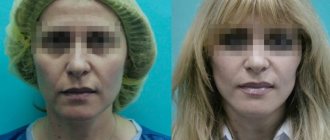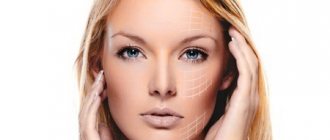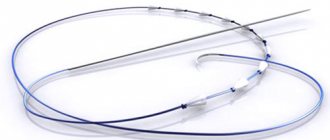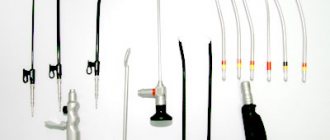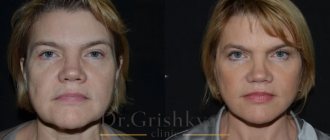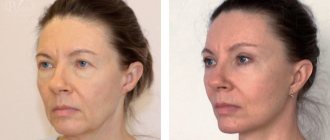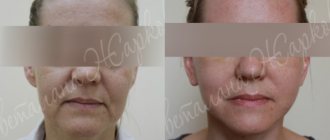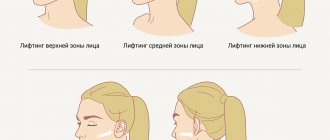A circular facelift in our clinic includes a SMAS face and neck lift. To achieve sustainable results, we use high-precision equipment and advanced endoscopic and minimally invasive techniques used in modern plastic surgery. We have accumulated extensive practical experience in performing anti-aging surgeries on the face and neck. We apply a comprehensive and individual approach to each patient, thanks to which we obtain a natural and long-lasting effect of facial rejuvenation.
What is SMAS and why is it needed?
What is a SMAS facelift and how does it differ from other types of facelift? The term SMAS is translated into Russian as Superficial Muscular Aponeurotic System. This is the tissue located between the skin and the deep muscles and fascia of the face. It is very important for facial rejuvenation because:
♦ It is this tissue that sags the most with age ♦ It can be strongly stretched and securely fixed in a new place without the side effects that are characteristic of strong skin tension
How to prepare for a consultation
The first step to plastic surgery for facial rejuvenation is a consultation with a plastic surgeon. We live in dynamic times and we value your time. In order for the consultation to be as effective as possible, at home, in a calm environment, decide for yourself what exactly you don’t like about your appearance. Dig through old photographs, find the ones you like, and take them with you. This way we will be able to identify those age-related changes that need correction, and quickly come to an agreement on the necessary methods. For example, looking in the mirror day after day, it is difficult to notice how the volume of tissue on the cheeks or the volume of the chin has decreased. Looking at a photo from 10-20 years ago, it’s easier to imagine what we want to get.
Write a list of questions that interest you and do not hesitate to bring it up during the consultation. Leave space between questions for notes. Over the years, we have developed an information sheet that contains answers to the most frequently asked questions about facial rejuvenation. You will receive it during your consultation so you can read it calmly at home.
If you would like to take a loved one with you to the consultation, whose opinion you trust, please do so. It is important that your companion understands that he is coming to support you and suggest some questions that you may forget to ask.
Radiofrequency liposuction
Irina Dubtsova before and after losing weight
There are many ways to combat a double chin or a sagging neck. For example, do classic liposuction followed by partial platysmoplasty (neck surgery) or resort to a simpler method - radiofrequency liposuction using the Face Tite device, which combines liposuction and lifting.
Briefly about the operation. Radiofrequency liposuction is considered low-traumatic, does not leave scars or cicatrices (because it leaves no sagging tissue that needs to be excised and removed), which, of course, makes this intervention also invisible to others.
The recovery period is minimal. And the effect of the procedure is noticeable immediately and gradually increases, as the production of your own collagen is stimulated. It is especially worth noting that after the intervention, the new appearance will delight you from 5 to 15 years.
How to prepare for surgery
If your determination to look younger after the consultation has strengthened, decide on the date of the operation and coordinate it with the clinic by calling +7(495)2269647.
One month before surgery, you should quit smoking and stop taking hormonal contraceptives and weight loss medications. If you are constantly taking any medications, please agree on their use with us.
2 weeks before surgery you need to undergo an examination. The results of the examination must be sent to us by email. Based on the results of their assessment, we will contact you. If you have no contraindications for surgery, we continue preparations. At home, prepare sterile gauze wipes and medical alcohol (vodka or other strong alcohol is also suitable), and painkillers or powders - Nimesil, Ketanov, etc. They will be needed after surgery. There is no need to take them to the clinic.
The night before surgery, eat your normal dinner.
On the morning of the operation you should neither drink nor eat. You can only take a sip of water. Take your passport, money, and toiletries with you to the clinic. Dark glasses and a headscarf are also needed to hide from prying eyes when you go home. Think about transport. The ideal option is for someone close to you to pick you up the day after the operation. If not, you can call a taxi to the clinic. Taking public transport or driving alone is a bad idea.
How does the operation take place?
The essence of the operation is to move sagging tissues to their original place and restore volume in those places where years have deprived the face of its original state. The contour of the face, which becomes more square with age, again takes on an oval shape. The clear contour of the lower jaw and a beautiful angle between the neck and chin are restored.
The operation is performed under general anesthesia. Our clinic provides modern combined anesthesia. This means that a minimum of substances that affect the central nervous system will be used, your body will be constantly saturated with oxygen, and after anesthesia there will be no nausea or headaches.
After the operation you will wake up quickly. There will be a bandage on your head, and medical personnel will be nearby to answer all the questions that usually arise.
Postoperative period
The recovery period lasts 2-3 weeks. After a few days, the patient returns to his normal rhythm of life. Basic recommendations for the postoperative regimen are outlined here.
Antibiotic prophylaxis consists of intravenous administration of an antibiotic on the operating table. You do not need to take an antibiotic after surgery.
We allow you to take a shower and wash your hair immediately after you have removed the bandage, that is, as a rule, 2-3 days after the facelift surgery. A special plaster is glued to the postoperative sutures, replacing the surface sutures; it does not need to be removed. It holds up well to two weeks of daily showering before the stitches are removed. If you are afraid of washing your hair at home yourself, you can come to the clinic, our specialists will wash your hair in a hairdressing chair specially installed in the dressing room, after which the surgeon will process and examine the stitches. We do not prescribe compression garments after a facelift; we consider them unnecessary.
The main thing in postoperative rehabilitation is physical and emotional peace. For three weeks, we recommend abstaining from the gym, swimming pool, alcohol and smoking. You can walk, do quiet household chores, mental and creative activities. No conflicts! If there are any showdowns in your life, please postpone it for three weeks. You can fly on an airplane the very next day after surgery.
Postoperative sutures should be wiped with alcohol or strong alcohol 2 times a day, and then lubricated with a nourishing cream. Foundation and decorative cosmetics can be used a week after the facelift.
Although the surgery uses absorbable suture material, suture removal is still necessary. This is the technology. To do this, you will need to come to the clinic 2 weeks after the operation. Removing sutures is a painless procedure and takes 10 minutes.
You can go out in public without fear of attracting unwanted attention from others in 12-14 days. During this period, there may be barely noticeable swelling and remnants of bruises on the neck, which are easily hidden with a scarf. As a rule, patients go to work at the same time. In general, the period for returning to work after a facelift is determined by the nature of the work and your attitude to what others will think. In general, performance is restored within a week after the operation. But if you want no one to notice anything, you need to have 3 weeks left.
You can resume sexual activity 2 weeks after the facelift. Sunlight should be avoided while there are bruises, that is, 2-3 weeks.
| event | How long after surgery can this be done? |
| To wash hair | 2-3 days |
| To drive a car | 7 days |
| Going to work | 2 - 3 weeks |
| Removing stitches | 2 weeks |
| Sex life | 2 weeks |
| Sunbathe in the sun or in a solarium | 2 -3 weeks until bruises disappear |
| Fitness with a gentle load | 3 weeks |
| Pool | 3 weeks |
| Mandatory follow-up visit to the doctor | 2 months |
A visit to a cosmetologist after surgical facial rejuvenation is welcome, but here there are certain restrictions. Before you begin the procedure, inform your cosmetologist that you have had surgery.
| EVENT | HOW LONG AFTER THE OPERATION CAN THIS BE DONE? |
| Lymphatic drainage facial massage | 1 Week |
| Microcurrents | 1 Week |
| Gentle cosmetic care, without mechanical cleaning | 10 days |
| Botox or Dysport injections | 3 weeks |
| Peeling | 1 month |
| Face massage | 1 month |
| Laser resurfacing | 1 month |
| Injections of hyaluronic acid preparations | 6 months |
After surgical facial rejuvenation, the areas of skin in front of the ears become insensitive for several months. If you use hot tongs or hair straighteners, be extremely careful not to get burned.
Goodbye furrowed eyebrows, drooping eyelids and heavy eyes!
Let's start with the upper eyelids. Hanging skin over the eyes is usually associated, firstly, with aging and drooping eyelid skin, and secondly, with ptosis (drooping) of the eyebrows. Therefore, in order to return our face to its original features, we need to not only eliminate excess skin on the upper eyelids (which is what upper blepharoplasty is limited to), but also raise the eyebrows (a separate operation was previously performed for this).
Photo 2. Eyebrow and eyelid lifting – Dr. Bely’s original technique.
Possible complications
Modern technologies make it possible to carry out face lifting with minimal risk to health. But, nevertheless, complications are possible.
Hematoma is an accumulation of blood under the skin. This complication occurs almost exclusively in patients suffering from hypertension. Moreover, if the diagnosis is known, the treatment is correctly selected, the risk of hematoma is minimal. The problem arises when a patient undergoes a facelift who has not paid attention to periodic, perhaps rare, increases in blood pressure, and is not aware of his problem. To protect yourself from this complication, it is necessary to expand the scope of the preoperative examination.
Another complication of a facelift associated with poor preoperative preparation is necrosis (death) of the skin. This problem is the lot of smokers and patients with decompensated diabetes mellitus.
The most unpleasant complication, which, fortunately, is extremely rare, is damage to the branches of the facial nerve. Fortunately, in the vast majority of cases, facial nerve function recovers on its own within a few months.
If the operation is performed by an experienced surgeon, a full preoperative examination has been performed, and the patient fully complies with the doctor’s recommendations, then the likelihood of negative consequences will be minimal.
Is it necessary to do modeling before a facelift?
Modeling is possible at your request. But modeling is just animation. It is better to look at the “before-after” results of patients who have undergone a facelift.
What is described in the article is a general concept of the approach to age-related changes in the face. Naturally, an individual approach to each patient is required each time. Remember the basic principle of lifting: until the tissues are mobilized and separated, it is impossible to lift them. Everything will quickly return to its original position.
Prices
| PLASTIC SURGERY | PRICE, |
| SMAS – facelift | 350 000 |
| Neck plastic surgery (platysmoplasty) | 350 000 |
| SMAS – face and neck lift | 450 000 |
| Circular facelift | 690 000 |
| SMAS face and neck lift + endoscopic lift of the upper two thirds of the face | 750 000 |
| Check-lifting | 250 000 |
| Enlargement of cheekbones | 250 000 |
Do you want to get rid of wrinkles, a double chin, sagging cheeks and a “heavy” look from under drooping eyelids? Come to our clinic. At your appointment you will find out how much a circular facelift in Moscow costs in your case.
Blepharoplasty
Blake Lively in 2007 and 2022
The operation helps to get rid of signs of fatigue, make the look more open and, of course, rejuvenate the face.
Briefly about the operation. Upper eyelid blepharoplasty is performed under local anesthesia and takes less than an hour. You can go home a maximum of two hours after the procedure. The sutures are removed on the third or fourth day, and the total recovery period takes from five to seven days.
Lower eyelid surgery is done transconjunctivally (the suture remains inside, there are no traces outside). Swelling after surgery lasts no more than three to five days. You can enjoy your wide-open gaze for 5 to 10 years (it all depends on individual characteristics).
